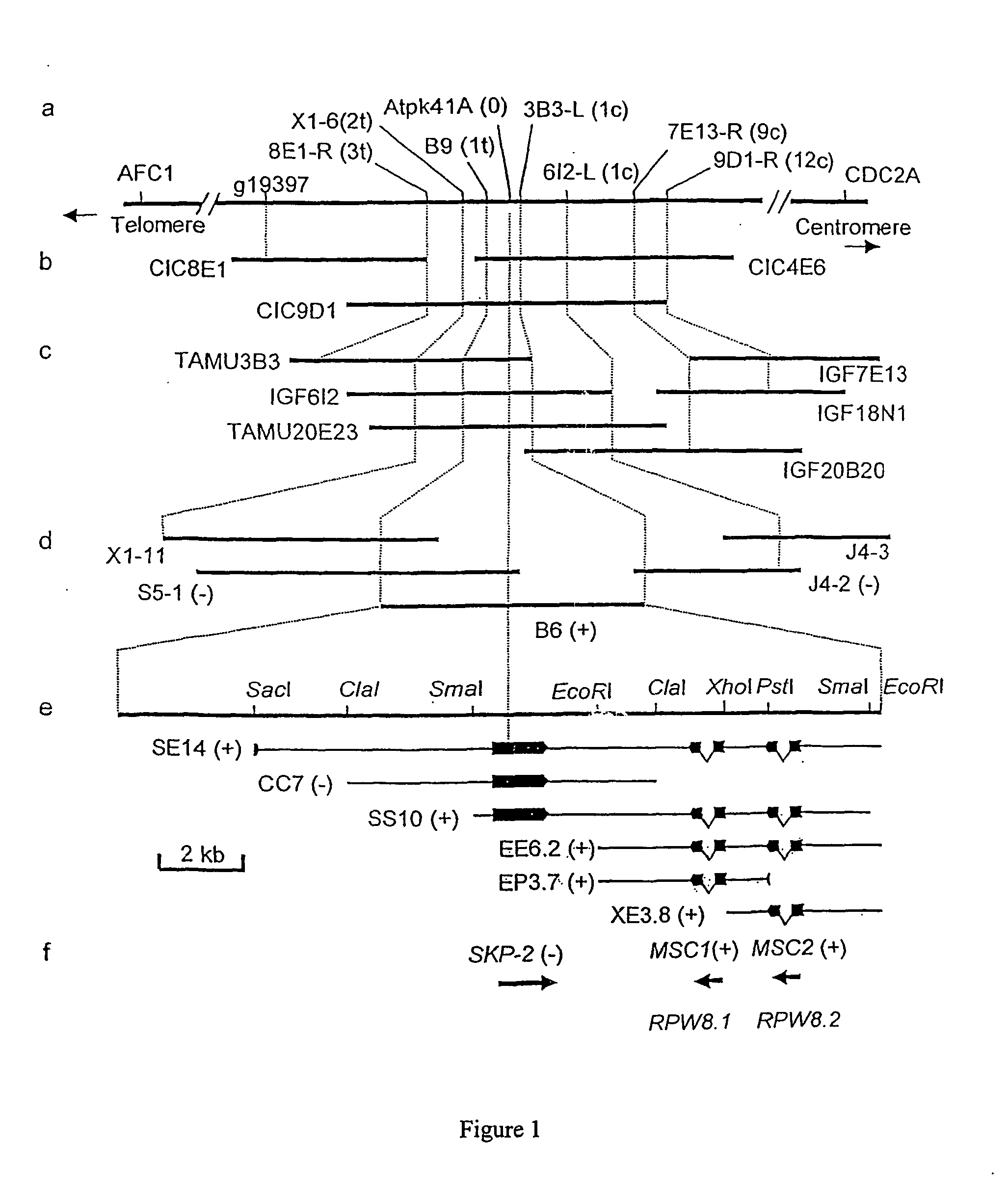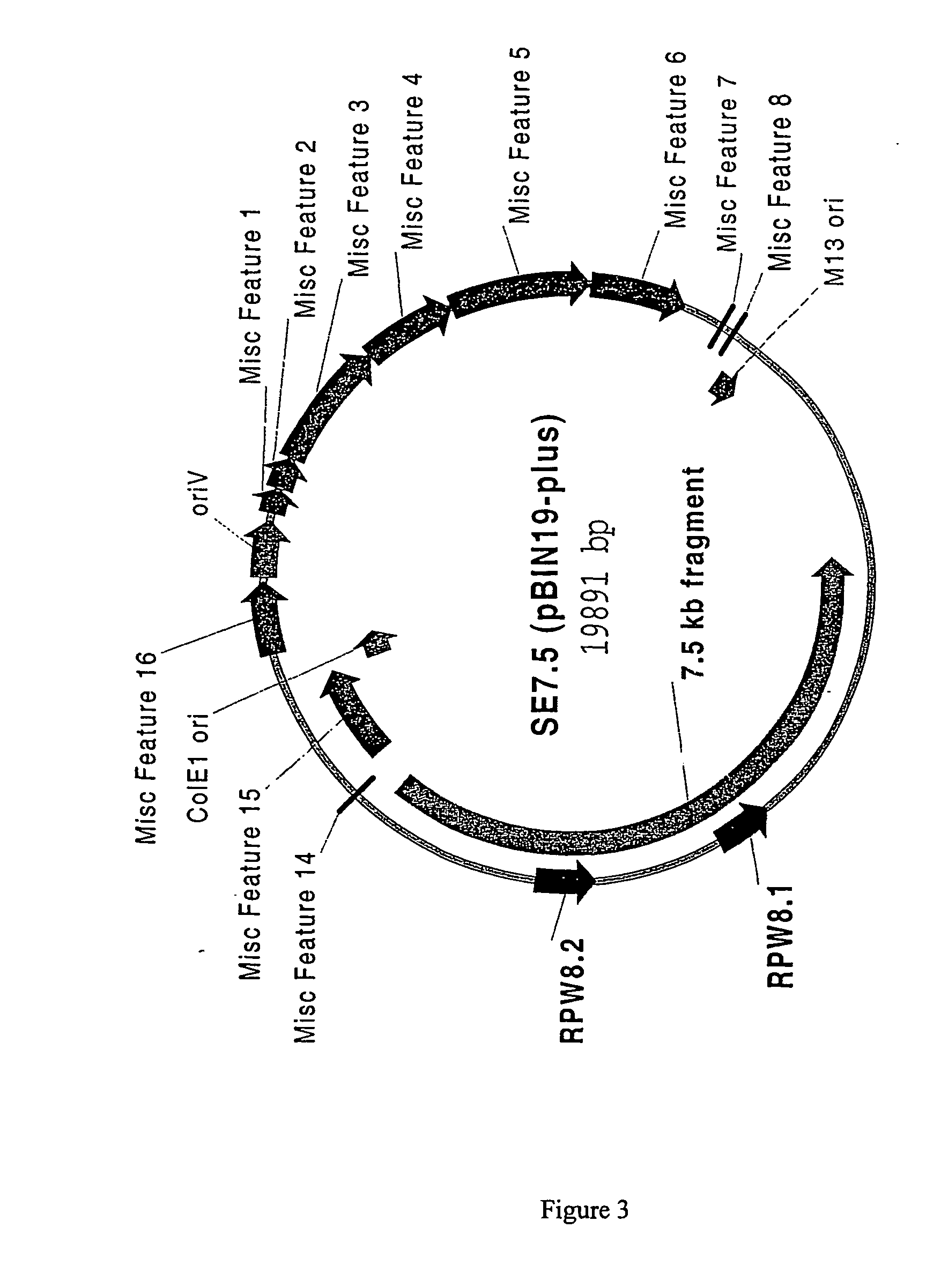Plant resistance gene
- Summary
- Abstract
- Description
- Claims
- Application Information
AI Technical Summary
Problems solved by technology
Method used
Image
Examples
example 1
Localisation of RPW8
[0133] Plasmid B6
[0134] A. thaliana accession Col-0 is susceptible and accession Ms-0 is resistant to infection by E. cichoracearum UCSC1.
[0135] This was confirmed by observation 10 days after inoculation (results not shown) after which time Col-0 supported growth of superficial white mycelium whereas Ms-0 did not. Resistance of accession Ms-0 is controlled by the RPW8 locus which maps genetically to an 8.5 cM interval, flanked by markers CDC2A and AFC1(8) (FIG. 1a). A population of 1,500 F.sub.2 plants from a cross between accessions Ms-0 and Ler (susceptible to E. cichoracearum UCSC1) was screened to detect individuals with recombination break points between markers g19397 and CDC2A (FIG. 1a). The ninety-four recombinants recovered were used to fine-map RPW8. Their genotypes at the RPW8 locus were deduced by scoring F.sub.3 progeny for resistance or susceptibility to E. cichoracearum UCSC1. Their genotypes at selected RFLP markers in the g19397 and CDC2A interv...
example 2
Characterisation of Specificity Controlled by RPW8
[0141] A range of pathogens virulent on A. thaliana accession Col-0 were used to characterise the specificity of resistance controlled by RPW8. Transgenic plants T-B6, T-35s::RPW8.1 and T-35s::RPW8.2 were resistant to all of the tested powdery mildew pathogens. These included 15 isolates of E. cichoracearum, and E. cruciferarum isolate UEA1, E. orontii isolate MGH, and Oidium lycopersici isolate Oxford, representing four distinct species(11). These results indicate that RPW7, which controls resistance to E. cruciferarum UEA1 and maps with RPW8 between markers CDC2A and AFC1(8) (FIG. 1a), may be identical to RPW8.1 and RPW8.2. Significantly, T-B6 plants were susceptible to other pathogens, including the fungus Peronospora parasitica Noco2 to which Ms-0 was resistant (testing 7 days after inoculation for white sporagiophores, results not shown), the cauliflower mosaic virus, and to the bacterium Pseudomonas syringae pv tomato DC3000 (r...
example 3
RPW8 Homologues from other Accessions
[0142] RPW8.1 produced a 908 nt transcript with a single 197 nt intron and 444 nt of predicted coding sequence, and RPW8.2 produced a 926 nt transcript with a 128 intron and 522 of predicted coding sequence (Sequence listing 1 & 2).
[0143] We examined the sequences of RPW8.1 and RPW8.2 homologues in seven other A. thaliana accessions with different levels of resistance to E. cichoracearum UCSC1. Accessions Kas-1 and Wa-1 are strongly resistant(12, 13), and a major resistance gene in each has been genetically mapped to the RPW8 locus (S. Somerville, personal communication). RPW8.1 and RPW8.2 homologues were amplified from Kas-1 and Wa-1 by PCR, and the DNA sequences were identical to those of the corresponding Ms-0 genes in Sequence listing 2. RPW8.1 and RPW8.2 homologues were also amplified by PCR from the moderately susceptible accessions, Ler, Nd-0, and Ws-0. Their derived amino acid sequences differed from those of the corresponding Ms-0 genes ...
PUM
| Property | Measurement | Unit |
|---|---|---|
| Fraction | aaaaa | aaaaa |
| Angle | aaaaa | aaaaa |
| Fraction | aaaaa | aaaaa |
Abstract
Description
Claims
Application Information
 Login to View More
Login to View More - R&D
- Intellectual Property
- Life Sciences
- Materials
- Tech Scout
- Unparalleled Data Quality
- Higher Quality Content
- 60% Fewer Hallucinations
Browse by: Latest US Patents, China's latest patents, Technical Efficacy Thesaurus, Application Domain, Technology Topic, Popular Technical Reports.
© 2025 PatSnap. All rights reserved.Legal|Privacy policy|Modern Slavery Act Transparency Statement|Sitemap|About US| Contact US: help@patsnap.com



